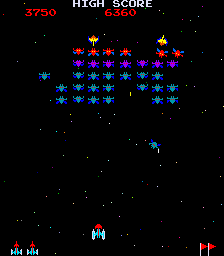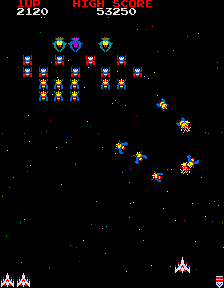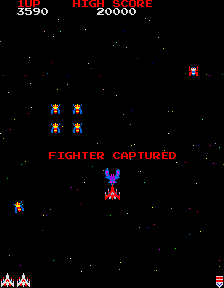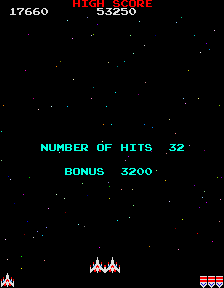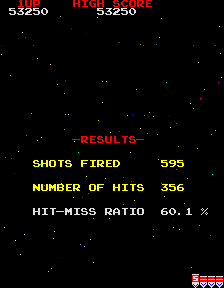 |
|||||||||||
![]()
Galaga
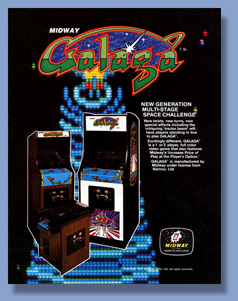 Bally/Midway 1981 (KLOV entry)
Bally/Midway 1981 (KLOV entry)
Reviewed by Dave Dries
Galaga is a good game. You hardly need me to tell you that. History has already made this determination. More than 20 years after it was released, Galaga has spawned countless updates, sequels and remakes that attest to this. But what is it about this simple game that has proven to be so popular and stood the test of time?
After the phenomenal success of Taito's Space Invaders in 1978, Namco wanted to cash-in on the craze and develop their own game based on the winning Space Invaders formula. The result was Galaxian. In contrast to the crude, overlayed colors of Space Invaders, Galaxian used a display that was capable of rendering graphics in full-color. And instead of the predictable marching pattern of the Space Invaders, the Galaxian invaders could fly around the screen and attack in waves. While Galaxian was moderately successful, it never reached the popularity of Space Invaders. But it was successful enough to spawn a sequel: Galaga. Galaga further refines the Space Invaders formula by recycling the gameplay variations added by Galaxian and incorporates several unique elements that make it stand out, and in some ways, overshadow its predecessors.
Galaxian. The spin-off that spawned a thousand spin-offs. |
A quick glance at the Galaga screen shows graphics almost identical to Galaxian. A star field background scrolls down the screen as different alien ships assemble in formation. Protected at the top of this formation is a line of larger Galaga aliens. Unlike the weaker aliens at the bottom of the formation these aliens can only be destroyed with two shots. Your ship is placed at the bottom of the screen where you can move only left or right to avoid attacking aliens and launch your own attacks.
Galaga. The spin-off that spawned nine-hundred and ninety-nine spin-offs. |
Aside from a few cosmetic changes and the addition of bonus waves between attacks, the only significant difference between Galaxian and Galaga is the addition of the tractor beam. The top row of Galaga aliens are equipped with a tractor beam that, when activated, can swoop down and capture your ship in a conical beam of blue light. If you lose a ship to this beam the Galagas will take your captured ship and transport it to the top of the alien formation where it will be turned against you and added to the advancing alien fleet. But all is not lost. The Galaga that captured your ship will escort your captive spacecraft in subsequent attacks. A well placed shot to the Galaga escort will release your captured craft sending it spiraling back down where it will link up with your new ship and give you double firepower!
All part of my master plan... |
The fool! He's playing right into my hands! |
While the addition of the tractor beam may seem like a simple addition, it really adds a new level of gameplay and strategy to Galaga. Because retrieving a captured ship will give you double firepower it really is in your best interest to allow one of your ships to be captured. And hitting the fire button and sending two shots flying up towards your enemies can be very satisfying. Not to mention without the added firepower getting through later levels and bonus rounds becomes increasingly difficult. But this also increases the risk of accidentally shooting your own craft and prematurely reducing your ship inventory and ending the game.
Galaga takes great pride in reminding you how bad you are. |
Yeah, yeah. Rub it in. |
Playing Galaga in MAME is arguably less exciting than paying to play the arcade game. Inserting a credit in a Galaga machine offered the promise of good gameplay and the opportunity to gamble with your skills and money for an enhanced game experience. But gambling on allowing your ship to be captured could also result in a shortened game if you failed to recapture it. And when you had a finite number of credits in your pocket, playing Galaga could either stretch your gaming time or send you home early searching for more money.
Because Galaga built on the winning formulas established by other games before it like Space Invaders and Galaxian in some ways it really couldn't go wrong. At the same time, lack of variety in later levels and the simplistic graphics do eventually wear on you and make you wish that Namco had made Galaga an even more deluxe version of its predecessors. But Galaxian's legacy doesn't end with Galaga. Namco eventually went on to add to the formula with other games like Gaplus and Galaga '88. While these newer games added gameplay elements and enhanced graphics they never really were able to capture the simple, addictive play offered by Galaga. Which is probably why 20 years after its original release, it's still quite common to see battered Galaga machines at Namco owned arcades. Usually standing somewhere in a back corner next to an aging Ms. Pac-Man game, another Namco classic from 1981. In 2001 Namco released their popular Galaga and Ms. Pac-Man titles in a 20-year reunion single cabinet model so a new generation of gamers can experience the classic gameplay of Galaga.
Rating
